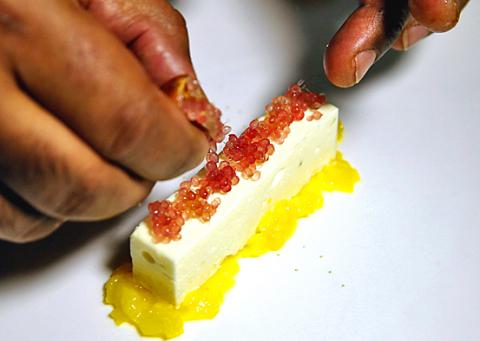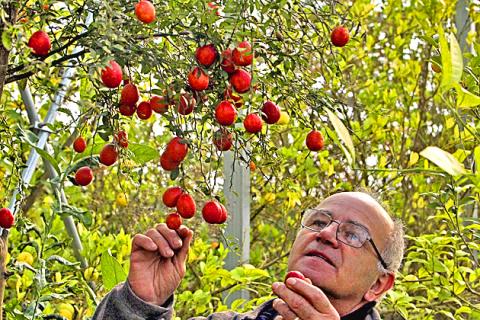French wholesaler Alain Cohen is the gastronomic equivalent of a gold digger, constantly on the lookout for new culinary treasures. When he makes what he thinks is a major find he presents it to French celebrity chef Alain Ducasse — usually to discover Ducasse got there first. With one exception.
“The only time I caught him out was with citrus caviar,” says Cohen, who specializes in fruits and vegetables.
Plucked from the obscurity of the Australian rainforest, the small gherkin-shaped citrus is the hottest new thing in French cuisine.

Photo: AFP/Raymond Roig
When squeezed, the microcitrus australasica — also known as finger lime — releases tiny caviar-like pearls of tart juice. A few seeds on an oyster, sushi, salmon or salad packs a powerful alchemical punch.
“The first time I tasted it I was overwhelmed,” Antoine Heerah, a Paris chef who trained under Michelin three-star supremo Alain Passard, says, describing the fruit as “both
‘PLAYFUL AND REVOLUTIONARY’

Photo: AFP/Patrick Kovarik
Playful, because the tiny pearls roll under the tongue and explode in the mouth, releasing a bitter, citrus flavor that is more acidic than a lime but softer than a lemon. For Heerah, who runs the Chamarre Montmartre restaurant, the new ingredient is “very 21st century” — simple to use but with the power to turn the mundane into the magical.
‘PLAYFUL AND REVOLUTIONARY’
Both Cohen and Heerah are disciples of Michel and Benedicte Baches. At their farm near Perpignan in southern France the couple both cultivate new citrus fruits and inject new life into existing varieties.

Photo: AFP/Raymond Roig
Michel happened upon the fruit about 25 years ago, shortly after Australian citrus growers brought it in from the wild and started cultivating finger lime.
Using imported seeds he began growing and experimenting with natural hybrids until he came up with his own variety, which he named “citron caviar” (citrus caviar).
The Australian fruit contains yellow seeds that are spicy in the mouth, with an acidic aftertaste. The skin, which can be dried and grated, contains notes of lemongrass and lemon balm.
The version developed by the Baches resembles a big olive, with a pink skin tinged with green and pearly pink seeds that are less sharply acidic and have a grapefruit or red fruits aroma.
Adding to its appeal, as Michel points out, is the fact that it has “no pips!”
“Demand has not stopped growing since 2000,” said Georgie MacDougall of Australia’s Wild Fingerlime Group, who exports the delicacy to Europe.
The celebrated Spanish chef Ferran Adria, who pushed the boundaries of cuisine with hi-tech methods to deconstruct and rebuild food in surprising ways, is touted as one of the first to use it on the continent.
“You must think of it as a condiment that can be used on sweet or savory dishes,” says Heerah. “On its own, it’s perfect on raw food, like carpaccio of scallops or sea bass. It creates a spectacularly attractive effect.”
Removing the caviar gently from the fruit he lays it on a creme chiboust, a type of pastry cream, that he has blended with a lime frozen parfait, then adds a drizzle of honey and pours on a coulis made from another fashionable citrus fruit, the Japanese yuzu.
‘EXPLODES IN THE MOUTH’
Renowned chocolate sculptor Patrick Roger uses citrus caviar seeds in a lemon ganache, wrapped in a half sphere of dark chocolate.
“The chocolate surrounding the citric acid creates alchemy and explodes in the mouth,” he says.
As the word gets out, the lime’s luxury cousin is finding its way onto the high street, into France’s luxury grocers.
With a retail price of about US$117 per kilo — more than twice the price in Australia — it’s one of the world’s most expensive citrus fruits.
The high cost reflects the limited supplies of the produce.
Baches, the only known grower of citrus caviar in France, produces some 800kg to 900kg a year. He is currently working on a new variety crossed with blood oranges, which should yield red seeds.
Outside of France, the Australians are getting back into the fruit, and the Californians and Israelis are also starting to grow their own, but for the moment, citrus caviar is still — as befits the name — a niche business.

Aug. 4 to Aug. 10 When Coca-Cola finally pushed its way into Taiwan’s market in 1968, it allegedly vowed to wipe out its major domestic rival Hey Song within five years. But Hey Song, which began as a manual operation in a family cow shed in 1925, had proven its resilience, surviving numerous setbacks — including the loss of autonomy and nearly all its assets due to the Japanese colonial government’s wartime economic policy. By the 1960s, Hey Song had risen to the top of Taiwan’s beverage industry. This success was driven not only by president Chang Wen-chi’s

Last week, on the heels of the recall election that turned out so badly for Taiwan, came the news that US President Donald Trump had blocked the transit of President William Lai (賴清德) through the US on his way to Latin America. A few days later the international media reported that in June a scheduled visit by Minister of National Defense Wellington Koo (顧立雄) for high level meetings was canceled by the US after China’s President Xi Jinping (習近平) asked Trump to curb US engagement with Taiwan during a June phone call. The cancellation of Lai’s transit was a gaudy

From Godzilla’s fiery atomic breath to post-apocalyptic anime and harrowing depictions of radiation sickness, the influence of the nuclear bombings of Hiroshima and Nagasaki runs deep in Japanese popular culture. In the 80 years since the World War II attacks, stories of destruction and mutation have been fused with fears around natural disasters and, more recently, the Fukushima crisis. Classic manga and anime series Astro Boy is called “Mighty Atom” in Japanese, while city-leveling explosions loom large in other titles such as Akira, Neon Genesis Evangelion and Attack on Titan. “Living through tremendous pain” and overcoming trauma is a recurrent theme in Japan’s

As last month dawned, the Democratic Progressive Party (DPP) was in a good position. The recall campaigns had strong momentum, polling showed many Chinese Nationalist Party (KMT) lawmakers at risk of recall and even the KMT was bracing for losing seats while facing a tsunami of voter fraud investigations. Polling pointed to some of the recalls being a lock for victory. Though in most districts the majority was against recalling their lawmaker, among voters “definitely” planning to vote, there were double-digit margins in favor of recall in at least five districts, with three districts near or above 20 percent in